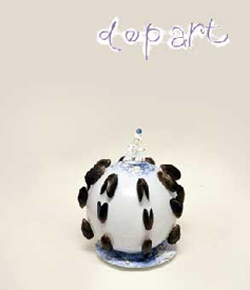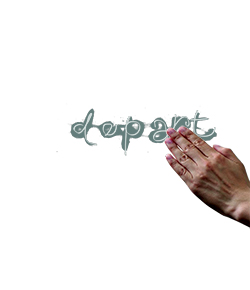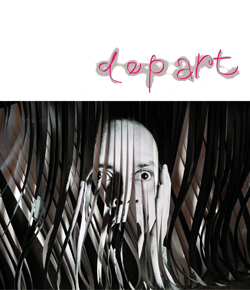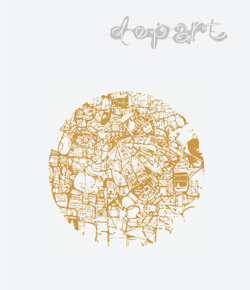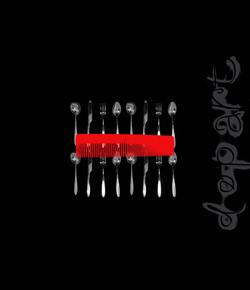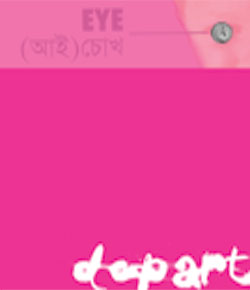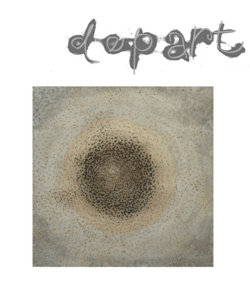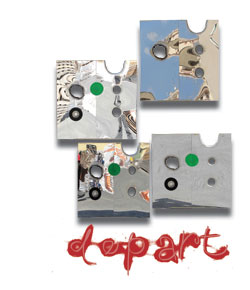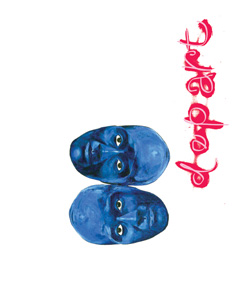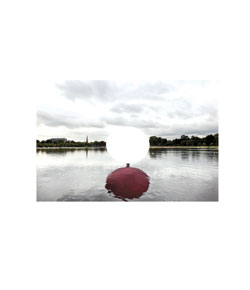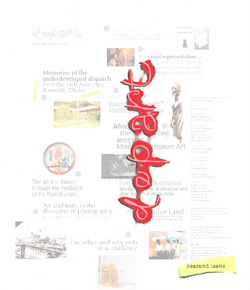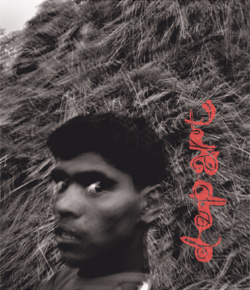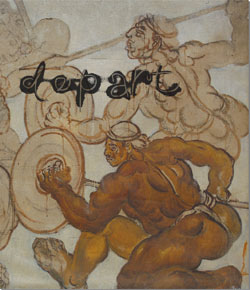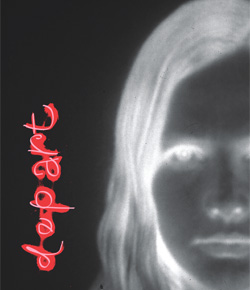navigator
Presence/Absence

Reality unfolds in ceaseless waves of possibilities and contradictions. Audacity of the arts is such that it attempts to rein in this untamable realty, and instead of stopping at that also aspires to transcend it. To try and apprehend the vagaries of reality sometimes overwhelms the senses, snubs consciousness. Once awakened to the absurdity of real time events, one realizes she has been pushed to the margins of her perceived reality. She discovers herself in a state of creative destitution. An artist is just as much a mere mortal as the next person. How can she arm herself against the grain of such events with nothing but her artworks?

The scribe extraordinaire of Bengali language, Hasan Azizul Haq raised an existential question, 'Transports, communication, trade and commerce – all are essential for our survival, but what is left for us to attain after that? To my mind life begins from that point of departure. However, none of us are living this life.... tell me, what are you going to do with literature? With music? With fine arts for that matter?' This unexpected inquiry pops up especially because the society that is conducive to the emergence and evolvement of the arts is yet to supersede its biological limits, more so because the path to such transcendence is yet to be paved. Hasan iterates, 'How far are we going to diminish the human faculties?... mankind stands slighted, denigrated.'
While confronting the inconsolable anguish of thousands of people who suffered losses of various degrees in the Rana Plaza disaster, Dilara Begum Jolly found herself asking similar questions which found creative expressions in her latest crop of works. Though there is no answer disingenuous enough to rationally redress this dreadful reality.
The collapse of Rana Plaza, literal and metaphorical, is such a historical juncture where a number of axes come to intersect. As it is Bangladesh is caught in the world wide web of globalization and its attending voluptuous politics of consumerism, what had been laid bare before our very eyes through Rana Plaza is the horrifying picture of enslavement of workers by the mercantile hypnotic lore of 'cheap labour' that potentially threatens to burst the bubble of an economy predominantly 'manufactured' on export of garments. The Rana Plaza incident, though, did decisively unveil a disastrous calamity born of callous, retrograde industrial condition, was not the only one of its kind. Through a series of earlier incidents an ominous cloud was already gathering over the horizon.

In light of such infinitely grievous destruction of life, everything else becomes incongruous and irrelevant. And an artist finds herself squarely facing the eternal question of how to negotiate her tools of making art when her reality has been turned on its head.
In order to experience the horror of the incident first hand Dilara Begum went to the site. She internalized the agony that left a void in the hearts of the near and dear ones of the victims, listened to their heart rending laments, collected the posters carrying pictures of the ones missing in this manmade catastrophe. The works that she composed as a result of this encounter might have been her emotionally charged response in a way to release the pangs of horror. However, Jolly to our amazement displayed remarkable restraint in her works in dealing with the otherwise roiling, combustible reactions an incident like this could engender in an artist. She apparently realized how counterintuitive it would have been to attempt any high pitched notes in her compositions, which inevitably would have been drowned out by the immeasurable grimness of such overwhelming pain. She consciously rendered these artworks simple and sparse in content. The language followed suit and fell silent or slow. They felt more like speeding movie frames played on slow motion, so as to attenuate the gruesomeness of the event. The works invited the 'gaze' to focus steadily and intimately upon her works with an appeal more to a cerebral than emotive response from the audience.

Jolly previously have already tapped into the human cost of the follies of garments industry. After the accident at Tazreen Fashions, her subjects have been sacks wearily piled atop each other, dyed body parts, sewing needles running over shattered bones. As the paraphernalia of the garments industry transmogrifies into unidentifiable clob of flesh, so in the same vein man's autonomy is also crushed under the rubble. From the depth of Jolly's paintings in this series, burst forth a mortifying wail. In these works the emotional intensity is persistent and affective.
In her new oeuvre she with a steely resolve re-presents a reality inhabited by a pedestrian entourage of people and objects associated with the domestic space. Occasionally she creates cushions or blouses as art objects. Sometimes the protagonists are a bed, dressing table, chairs, etc. These deified objects occupy the honour of place at the centre of the canvas. The presentation- linear. The furniture or domestic paraphernalia stare out of the surface with a direct, unladen appeal. They resemble the objects in Francis Ponge's poems, which reveal nothing beyond themselves, though at the same time declaring a universality of 'presence'.
Conversely, Jolly dissolves this apparent indestructibility of the seen by overlaying each rarefied still life with the face of the missing people. The method applied is equally simple, the photocopied posters are plastered over the painting by first wetting them, a process that made the faces appear blurred. They are present in the objects in sight, but only so by means of their absence; though contained within the rhythms of the worldly parameters, they however are not active agents as much in their life as in death. Thus Jolly apparently couches her works in the tension between presence and absence.

This thematic treatment achieves the next level by way of the simple methods she sticks to. Due to techniques of imaging, the faces and texts are reversed on the posters. That is why, in spite of bearing the traces of the 'real', they appear as mere reflections /inflections, inhabiting the other side of mirrored reality.
Jolly appropriated the formal traits of nakshi kantha to give form to the domestic objects. On the one hand, this form becomes part of Jolly's artistic tool and on the other it also lends a quintessential feminine voice to tragedy chiefly seen within the feminine context. A tragedy that assumes a gendered overture, affecting women in their persons and by extension men they are existentially related to. The language of her art is equally simple as they alternate between that of the Nakshi Kantha and stitching garments, both expressly associated with female creativity and labour. A folk art form that brings into view the idyllic beauty of the rural landscape becomes the vehicle for the tragic narrative of the follies of globalization.
Jolly created her artifacts by pricking the paper with needles, and sometimes mimicking the flight of stitches over a quilt. The needlecraft on the quilts uses tacks as their basic means which appear on the cloth only to disappear underneath it in the next stroke. This rhythmic 'in and out' of the threads gives rise to the distinctive embroidered patterns that make the quilts so special. Jolly capitalizes on this very characteristic of the kantha stitches to reinforce her leitmotif of presence and absence.

Jolly's modus operendi: the projection of the female capacity for procreation is overtly manifest in her representations of the ovum, womb, uterus or breasts, parts of the sum of the reproductive system, which become parts of devising a personal idiom, appearing across the broad range of her art objects. How woman's ability to produce creatively paradoxically transmutes into a fatal threat to her existence, is what factors in Jolly's analysis of the discourse of art. In her current repertoire, women's productivity has been lent a new dimension, besides being a natural producer she becomes a producer of commodity. Her works often show the superimposition of pictures of fallen humanity upon images of uterus as the symbol of reproduction, thus by combining these diametrical opposites Jolly intends to invoke a sense of discomfiture. In a way the creator is ironically and fatalistically birthing her own demise. This devise finds expression in an installation work comprising of a bed covered in a black and white bed sheet, strewn with blood soaked pieces of clothing, in the wall behind the bed hang tassels in white made of swatches similar to those from the floors of a garment factory. They are also strung with tiny human figures, in the likeness of hanged corpses. The ambience is that of the bridal chamber, commonplace signifier of procreation, the inception of a lineage - but created out of the shroud of the dead.
The fact that human life is prey to manmade traps is approached by means of various symbolism; on the day of the exhibition Jolly left a cluster of inflated balloons in a chamber which over the duration of the art event have been slowly deflating on their own. The process of this gradual loss of air is not apparently invisible. Towards the end of the exhibition the notable change in the balloons were commuted to another signifier of death. Our attention was shifted from a sudden cause of death to the slow, silent and unaccounted for process of annihilation of life as a result of disparity and deprivation.
These current works by Dilara Begum Jolly raises discomfiting questions regarding loss of human life; questions encompassing within its ambit, concerns over an individual life to the discrepancies of world trade. These questions are veritably political and philosophical. Jolly's exhibition not only speaks out for the tragedy of the garment manufacturing industry but also presages an ominous existential peril that looms large over our destiny as a nation.
Bengal Art Lounge ran a solo by Dilara Begum Jolly entitled ‘Boyon Bayan’ (Threads of Testimony) from August 16 to September 4, 2014.
SAJJAD SHARIF is a poet and writer based in Dhaka. He is managing editor of ‘Prothom Alo’.
Translated by SHARMILLIE RAHMAN




